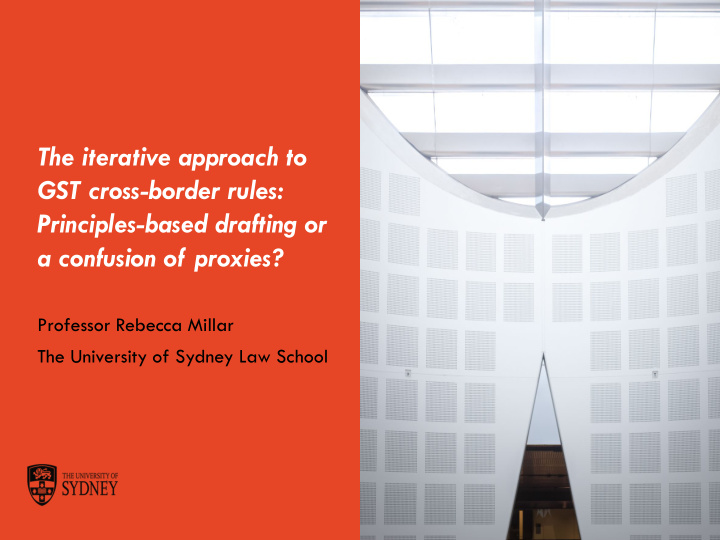



The iterative approach to GST cross-border rules: Principles-based drafting or a confusion of proxies? Professor Rebecca Millar The University of Sydney Law School The University of Sydney Law School Page 1
Iterative model: principles or a mess of proxies? – The criticism – The principle(s): Destination Neutrality – The OECD International VAT/GST Guidelines Outcomes v model/design/rules – The iterative model The University of Sydney Law School Page 2
Enforcement v Substantive Jurisdiction Enforcement Enforcement Substantive No Substantive No Enforcement No Enforcement Substantive No Substantive The University of Sydney Law School Page 3
Gordon Brysland – In stark terms, the concept of ‘principles-based drafting’ is used to contrast an open drafting style based on organic propositions rather than tightly prescriptive rules. By its essential nature, it takes a broad principle which is flexible and ‘covers a wide range of circumstances at a high level of abstraction’ – Top down and ground up approaches The University of Sydney Law School Page 4
Gordon Brysland – What seems to happen in practice is that factual scenarios snowball so quickly within tight legislative timeframes that (A) no attempt at ‘top-down’ drafting is ever in serious contemplation, and (B) the ‘ground-up’ type of approach has no real opportunity to take hold, much less succeed. The University of Sydney Law School Page 5
Greg Pinder – A principle is a statement about an intended outcome in a general field. – Some commentators have focused on the degree of specificity as the quality that separates a principle from the rules that usually make up black-letter law. – But a principle is not just a less specific rule; it is a statement about the essence of all outcomes intended within its general field. The University of Sydney Law School Page 6
Greg Pinder – When a principle works, it does so because the essence it captures appeals to readers at other than an abstract intellectual level; it means something to readers because it relates to their understanding of the real world. Principles cf Technical Model – The technical model is the set of conceptual building blocks and rules that creates rights and imposes obligations. – It is a necessary part of a law but need not exist independently of the principles it serves. – A source of the complexity of our existing tax laws comes from making the technical model an end in itself. The University of Sydney Law School Page 7
One example of incoherence – s 84-70 Meaning of electronic distribution platform (1) A service (including a website, internet portal, gateway, store or marketplace) is an electronic distribution platform if: (a) the service allows entities to make supplies available to end-users; and (b) the service is delivered by means of *electronic communication; and (c) any of the supplies that are *inbound intangible consumer supplies are to be made by means of electronic. (2) However, a service is not an electronic distribution platform solely because it is: (a) a carriage service (within the meaning of the Telecommunications Act 1997); or (b) a service consisting of one or more of the following: (i) providing access to a payment system; (ii) processing payments; (iii) providing *vouchers the supply of which are not *taxable supplies because of section100-5. The University of Sydney Law School Page 8
Recommend
More recommend